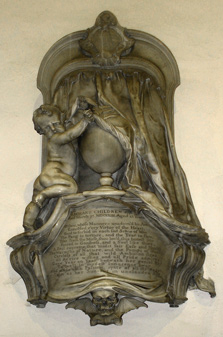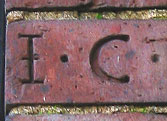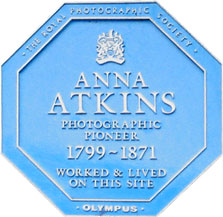The Children family
The Childrens (the name may indicate a connection with the Chiltern hills)
were a family established in Kent since at least the 14th century, with an
estate called ‘Childrens’ near Stocks Green, Hildenborough. An early George
Children (1606-70) was educated at Tonbridge School and became curate at the
parish church.
Richard Children lived at Ramhurst Manor, Leigh until his death in1753
(and was allegedly still haunting it a hundred years later). His
memorial in Tonbridge parish church, shown here, is by the noted sculptor Roubiliac, and
carries verses by James Cawthorne, the headmaster of Tonbridge School at the
time.
Richard’s son John (1706-71) was the first to live in Tonbridge town,
moving to Ferox Hall in about 1750 and adding the present brick frontage to the
existing house a few years later. The picture on the left shows his initials (I.C.) which
can still be seen carved into bricks on either
side of the front door.
George Children
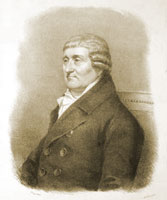
George Children at the age of 64
John Children was succeeded at Ferox Hall by his son George (c1742-1818), the first
member of the family to play a major part in the town’s affairs. A barrister who
never practised, he was a JP for half a century, under-sheriff for Kent and
Sussex, a proprietor of the Medway Navigation Company, and one of the founders
of the Tonbridge Bank.
He was also a close and devoted father to his only son,
John George, whose mother died six days after giving birth to him. George was a
kindly and much-loved Tonbridge figure, as his memorial in the parish church attests
(picture
).
John George Children
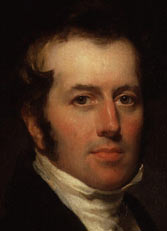
John George Children in 1826
John George Children (1777-1852) was a scientist at a time when science was
still largely a pursuit for gentleman amateurs. He was well-known in London
scientific circles, was elected a Fellow of the Royal Society at the age of 30
and later became its Secretary. His particular interests were in electricity and
the chemistry of minerals.
The young John George has been described as a man of exceptional
intelligence, greatly spoilt as a boy. Following his education at Tonbridge
School, Eton and Cambridge, he married, but like his father soon became a
widower when his wife died a year after the birth of their only child, Anna.
After a period of foreign travel, including a visit to the United States and
Canada which was cut short by ill-health, and a rock-collecting trip to Cornwall
and Wales, John George returned to Ferox Hall and began to devote himself to his
scientific pursuits, working in the purpose-built laboratory in the grounds of
Ferox Hall. Father and son worked together to construct
what Humphry Davy described in 1808, after the first of his many visits, as
their ‘magnificent experiments and apparatus’. Davy wrote that his days with the
Childrens were some of the pleasantest of his life.
In 1808 John George was involved in an accident when a sudden conflagration
during an electrical experiment threw caustic alkali into his eyes. Luckily the
damage was not permanent, but he advised anyone involved in similar work always
to wear goggles. Undaunted, the Childrens went on to construct the famous
giant
battery of 1813.
MY SINCERE WISH
Let me from noise and tumult fly
To quiet and obscurity;
Pleas'd let me quit the cares of wealth,
Content with competence and health ;
Title, ambition, glory, pow'r,
Obtrude not on my secret hour;
Fair science cheer my humble lot,
And virtue, tenant of my cot,
With pure religion guard my soul
From passion's dangerous, blind control ...
(Part of a poem by J. G. Children)
In 1811, John George was involved in setting up the Tunbridge
Gunpowder Company, together with his father, on whose land at Leigh the Powder
Mills were built, and other backers. Davy was also briefly involved in this enterprise.
By 1813 the Tonbridge Bank was on the point of collapse, bringing financial
ruin to the Childrens. Ferox Hall eventually had to be sold, and they moved to London,
where John George had to start earning a living. A post was found for him at the
British Museum, and he served there in various capacities for more than 20
years.
Like his father, John George was a good-tempered and generous man, and like
his father, he wrote poetry. He died in
January 1852 at his daughter Anna's home in Halstead and is buried at St George's,
Bloomsbury. His name is commemorated in an Australian snake‚ Children’s Python‚
and a mineral, childrenite. A 313-page Memoir of J. G. Children was published
privately by his daughter in 1853; a copy of
it can be read on the web
.
Anna Children (Anna Atkins)
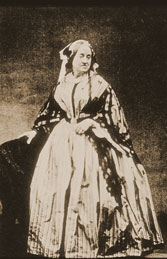
Anna Atkins photographed at the age of 62.
John George Children’s only child, Anna (1799-1871) was brought up by her
father and grandfather in the lively family home at Ferox Hall. From her father,
to whom she was particularly close, she gained practical skills and a love of
science unusual in a woman at that time. She was a botanist and also an
excellent illustrator who contributed more than 200 drawings to a book on shells
which her father had translated from the French.
In 1825 she married John Pelly Atkins, who would later become Sheriff of
Kent, and it is as Anna Atkins that she is best known – better known in fact than
her father or grandfather. There were no children and Anna devoted much of her
later life to photography, a field in which she is a notable pioneer.
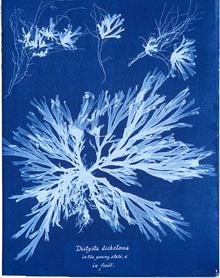
Cyanotype produced by Anna Atkins for her book on British algae.
The Childrens were friendly with two other important figures in the history
of photography, W. H. Fox Talbot and the astronomer John Herschel. Herschel
devised a photographic technique known as the cyanotype process, in which paper
was impregnated with a material which turned blue when exposed to light,
producing what were later known as blueprints. Anna Atkins used this technique
to create shadow images of botanical specimens, a pioneering application of
photography to science. Over ten years she was personally responsible for the
production of the more than 400 cyanotype plates needed for each copy of her
book ‘Photographs of British Algae’, based on her own seaweed collection. This
book was the first ever produced wholly by photographic means. The pictures in
it are of artistic as well as scientific interest and some of them survive today
in the collections of museums and galleries around the world.
One of Anna’s close friends was Anne Austen, a second cousin to
Jane Austen, who lived with the Childrens as a child. In later years the two sometimes co-operated in producing
cyanotypes of other natural objects, more for aesthetic than scientific
purposes.
Anna died in 1871 at her home, Halstead Place, between Knockholt and
Chelsfield in Kent, and is commemorated there by a blue plaque.
>You can read more about Anna Atkins' photographic work on the
Royal Photographic Society website.
The portraits and cyanotype on this page are out-of-copyright images from
Wikimedia Commons.
▲Top

